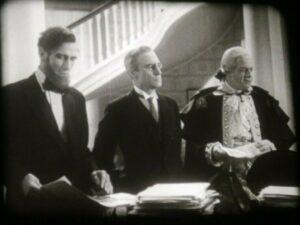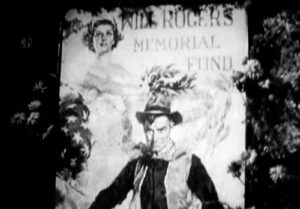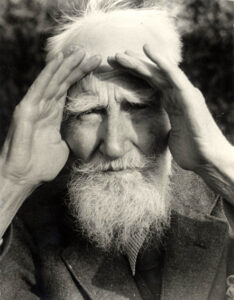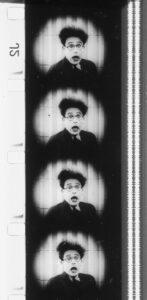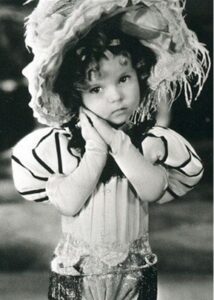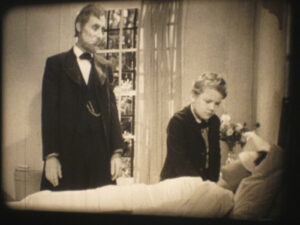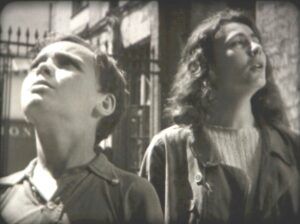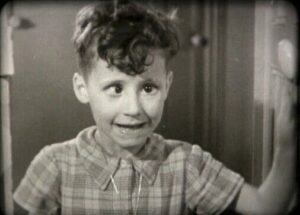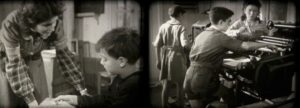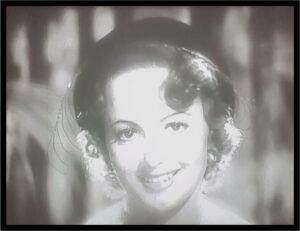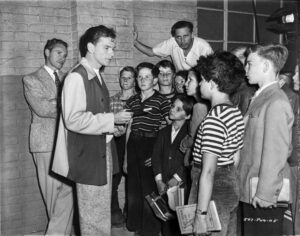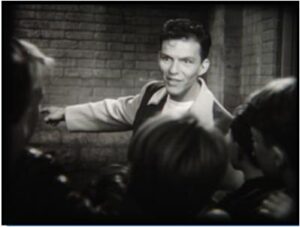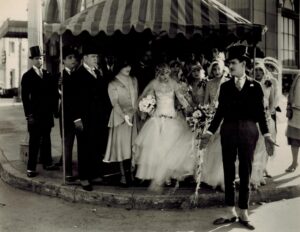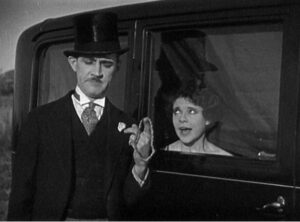
EVERY SUNDAY (MGM, November 28, 1936) The Sunday afternoon concerts in the park aren’t drawing an audience so they’re going to be replaced. Judy Garland (1922-1969) and Deanna Durbin (1921-2013) (their only film together, and Durbin’s screen debut) are determined to save the day. Durbin sings opera and Garland sings hot swing. The crowds come running, literally! Born just a few months apart, both girls were fourteen years old at the time of filming. (Undated Eastman film stock, V/A track) ___________________________________________
THE ROAD IS OPEN AGAIN (Warner Bros., 1933) Directed by Alfred E. Geen. Dick Powell as himself, Charles Middleton as Abraham Lincoln, Samuel S. Hinds as Woodrow Wilson and Alan Dinehart as George Washington. Also, Shirley Temple and Deanna Durbin as themselves promoting the American Red Cross. This rare film is a Great Depression morale booster for the National Recovery Administration, (NRA), and president Franklin Roosevelt. Dick Powell, (1904-1963), falls asleep at his piano while trying to write a song about the NRA and is visited by the spirits of presidents Washington, Lincoln and Wilson who assure him that the NRA and FDR will put the country right and that the road to prosperity will be open again. Inspired by this ghostly visit Powell sings his new song and then invites us to sing it with him. Following “The Road is Open Again” on the same reel are a 1935 plug to support the Red Cross featuring Shirley Temple, (1928-2014), a very brief snipe asking if you have purchased war bonds to avenge Pearl Harbor, and then another Red Cross plug, this one from 1940 and featuring Deanna Durbin singing new lyrics set to the WWI song “Roses of Picardy.” (music by Haydn Wood.) (Undated 3M film stock, variable area sound track) ________________________________________________
FOR AULD LANG SYNE (Warner Bros., April 29, 1938) Billed as a tribute to Will Rogers, this is really a fund raiser for the Will Rogers Memorial Hospital. Internationally popular entertainer Will Rogers died in a plane crash in 1935. In 1936 the Will Rogers Memorial Hospital was established to treat members of the entertainment industry who had contracted tuberculosis. Soon the mission was expanded to treat any child who needed medical care. Every year since that time the film industry has produced these films to raise money for the Rogers Hospital. Some 4000 35mm prints were struck for these charity fund raisers in the 30s, a far greater number than was struck for the standard Hollywood commercial release at the time. At the end of the film the theatre lights would come up and the ushers would walk through the isles with canisters to collect donations from the audience. In 1938 it was Warner Bros. turn to produce the Rogers fundraiser. This edition features James Cagney, Rudy Vallee, Donald Crisp and Paul Muni as Masters of Ceremony. They introduce performances that are actually clips from other films. Seen are The Benny Goodman Band with Benny Goodman, Lionel Hampton, Gene Krupa, Harry James and others performing “I’ve Got a Heart Full of Music” (music by Richard Whiting) in a clip from “Hollywood Hotel,” (Warner Bros. 1937), and Dick Powell and the KCBS Texas Rangers Band singing “Ride, Tenderfoot, Ride” in a clip from “Cowboy from Brooklyn,” (Warner Bros. 1938) Others stars seen arriving at film premiers from archive footage: John Barrymore, Freddie Bartholomew, Humphrey Bogart, Mayo Methot, Lili Damita, Bette Davis, Glenda Farrell, Louise Fazenda, Errol Flynn, Hugh Herbert, George Jessel, Harmon Nelson, Basil Rathbone, Hal Wallis and Marie Wilson. To close the film Paul Muni asks the ushers to pass among us to take up a collection for the Hospital, then the screen fades to black while we listen to an orchestra play “Auld Lang Syne.” (1974 Eastman film stock, variable area sound track) ____________________________________________
SHAW TALKS FOR MOVIETONE NEWS (Fox Film Corporation, June 25, 1928) George Bernard Shaw as himself. Cinematography by Bennie Miggins, directed by Jack Connoly and George Bernard Shaw. This early sound newsreel from Fox Movietone gives us a glimpse of one of the great playwrights and towering personalities of the twentieth century.
George Bernard Shaw (1856-1950), who was seventy-one years old at the time of filming, was the author of Pygmalian/My Fair Lady, Major Barbara, Man and Superman, Androcles and the Lion and a myriad of other works. We first see him walking on a gravel path at his home in Ayot St. Lawrence, Hertfordshire. He feigns surprise when he “sees” us all there, and then he chats amiably with the camera. He rambles about himself, meeting a little girl on the street who wanted his autograph, and abut Italian dictator Benito Mussolini. While he doesn’t say anything profound we do get a sense of his personality, that of a heavily bearded Puck. There is a twinkle in his eye that signals he may pull a prank on us at any moment, although he never does, unfortunately. Talking films were very much a novelty in 1928 and both the New York Times and Variety were mesmerized by this film, saying that Fox had staged a real coup by getting Shaw onto the talking screen. Shaw agreed to do this film provided he was allowed to direct! But Jack Connoly, from the Fox Film Corporation, was there anyway to make certain that they got what they needed. (3M film stock, variable area soundtrack) _____________________________________________
MICKEY’S MEDICINE MAN
(Larry Darmour Productions, May 18, 1934) Mickey Rooney, (1920-2014, born Joe Yule Jr.) began his astounding film career starring in a series of kid-comedies based on the popular Toonerville Trolly comic strip. Beginning in the silent era when Rooney was barely six years old, it continued into the sound era. Producer Larry Darmour convinced the Yules to legally change the name of their tiny titan to Mickey McGuire, the same name as his character. In 1934 the then thirteen-year-old Mickey left the series. His character was re-cast, but without his atomic personality the Mickey McGuire series soon folded. Mickey then changed his name again, this time to Mickey Rooney, and rose to the top of the motion picture world by the end of his teen years. In this film, Mickey and the gang need money fast and when they see a snake oil salesman they are inspired to create their own medicine and sell it. You won’t believe the results! This is a 1947 reissue print with Mickey’s last name changed from McGuire to Rooney in the credits. Other than that change, this is the original two reel version of this fun kid comedy. (1947 Kodak film stock) ____________________________________________
HIGH AND DIZZY (Hal Roach, July 11, 1920) Harold Lloyd’s second “thrill” comedy in which, through circumstances that are best seen in the film, he ends up balancing dangerously on the ledge of a building many stories above the street. Lloyd plays a young doctor just out of medical college. His practice is so slow that the telephone is covered in cobwebs from lack of use. “The Girl,” (played by Mildred Davis, the future Mrs. Lloyd) comes to his office seeking help for her sleepwalking. Wanting her to think he is a very busy physician Lloyd goes to elaborate (and very funny) lengths to make it seem that his office is full of patients. This is the 2004 restoration with all the original intertitle cards, excellent image quality and a great original musical accompaniment by the Paragon Ragtime Orchestra. (2004 ORWO film stock, variable area sound track) ______________________
GLAD RAGS TO RICHES
|
THE PERFECT TRIBUTE (MGM, August 15, 1935) Highly fictionalized and reverent account of Lincoln and his Gettysburg address, based on the oft told story written by Mary Raymond Shipman Andrews. Starring Chic Sale as Lincoln, Walter Brennan as Stone Cutter, George Ernest as Solder’s Young Brother, William Henry as Soldier, Leila McIntyre as Mary Todd Lincoln, William V. Mung as Old Story Teller. One of the great things about vintage movies is that they can open the door to parts of history that you never imagined. This film leads us to one of the unsung heroes of WWII. It is a fascinating story and I’ll tell you all about it at the screening! (1965 Eastman film stock, variable area sound track) _____________________________________________________
THE CHILDREN’S REPUBLIC (French title: La Petite République) A.F. Films (Les Actualites français), Madeline Carroll Productions, 1947. Commissioned by The Marshall Plan. Directed by Victor Vicas, produced “with the assistance of the children of the Republic of Sèvres.” Narrated in English by Madeleine Carroll, who also appears as herself. This film was used as a fundraising tool by UNICEF. Difficult times can produce amazing situations. WWII and the Nazi invasion of France destroyed families and shattered lives all over Europe. Countless children were orphaned and rendered homeless when their parents were either killed in the war or arrested by the Nazi’s and never returned. Many children lost arms and legs in the Allied bombings, and there were Jewish children who needed to be hidden. These were all children with desperate needs who found a home and an education at Maison d’enfants de Sèvres, (“House of the Children of Sèvres”).
|
